I recently went one on one with Radhika Dutt. Radhika is the author of the new book Radical Product Thinking: The New Mindset for Innovating Smarter.
Adam: Thanks again for taking the time to share your advice. First things first, though, I am sure readers would love to learn more about you. How did you get here? What experiences, failures, setbacks or challenges have been most instrumental to your growth?
Radhika: I’ve been an entrepreneur and product leader, have founded companies, and also worked for larger companies. My experience has ranged across a wide range of industries including broadcast, telecommunications, advertising technology, government, consumer apps, and even wine. Across these companies and industries, I found that it’s easy for good products to go bad. I repeatedly saw a pattern of “product diseases” such as Pivotitis, Strategic Swelling, and Obsessive Sales Disorder, that were getting in the way of innovation. Having caught many of these diseases myself, I realized the shortcomings of how we build products today and the need for a new, radical approach.
The result was Radical Product Thinking. We started by testing this as a framework with many different types of organizations in 2017 and it soon became a global movement. Today, organizations including startups, multinationals, nonprofits, and government agencies are using this approach to build radical, world-changing products.
Adam: What do you hope readers take away from your new book?
Radhika: The key to building world-changing products is being vision-driven instead of interaction-led. When we’re iteration-led, innovation becomes more short-term-oriented. Being iteration-led is like optimizing for a few chess pieces that are under attack in your game. You might be seeing this in your organization if you feel like you’re continuing to tweak your offering to optimize for financial metrics such as revenues or user engagement – this delivers results in the short-term but doesn’t always lead to long-term success. In contrast, when you’re vision-driven, you try to find the best moves across the whole chessboard. Instead of making small changes to the status quo, you build products that create a fundamental change.
Being vision-driven means starting with a clear vision for the change you want to see in the world and systematically translating it into reality – Radical Product Thinking: The New Mindset for Innovating Smarter gives organizations a clear methodology for being vision-driven and building world-changing products.
Adam: What are your best tips on the topic of product development?
Radhika: We have to start by unlearning what it means to have a good vision. Conventional wisdom says that a good vision is a BHAG (a Big Hairy Audacious Goal) and that it should be a short, memorable slogan. It turns out that this advice couldn’t be more flawed.
To align your team, instead of a short slogan or an aspirational goal, you need a detailed vision that articulates the problem you want to see solved in the world. It requires answering the Who, What, Why, When, and How questions:
-
Whose world are you trying to change?
-
What is their problem and how are they solving it today?
-
Why is the status quo unacceptable?
-
When will you know that you’ve arrived, i.e. what does the world look like when you’re done?
-
How will you bring about this world?
A Radical Vision Statement helps you write a detailed vision in a Mad Libs format so you can focus on answering these profound questions without resorting to a game of wordsmithing and vision bingo. Here’s an example of this vision statement filled out for a startup I founded in 2011 and sold in 2014:
Today when [amateur wine drinkers], want to [find wines they’re likely to like], they have to [pick wines based on attractive labels or try what’s on sale]. This is unacceptable because [it leads to too many disappointments]. We envision a world where [finding wines you like is as easy as renting movies on Netflix]. We are bringing this world about through [an algorithm that matches wines to your tastes, and an operational setup to deliver those wines to your table].
This example illustrates the power of a radical vision: even when you didn’t know anything about this startup, the vision statement told you exactly what we were doing and why. A clear vision that defines the end-state you want to bring about is only the first step. The RPT approach helps you systematically translate this vision into your everyday activities through the five elements of the methodology (vision, strategy, prioritization, execution and measurement, and culture).
Adam: How can leaders create a culture that fuels innovation?
Radhika: Culture typically seems like a nebulous concept and an abstract idea. But in the RPT way, you can systematically engineer the culture your team needs to fuel innovation. This requires starting with a clear vision for the culture you envision. Often the vision for culture is fluffy, for example “We want an open and transparent culture.” But it’s not clear what this means and how you achieve it.
The RPT approach to organizational culture helps you identify your work culture more concretely. RPT defines culture as the cumulative set of employees’ experiences on two dimensions: whether work is fulfilling or not, and whether work is urgent or not. When you visualize this on a 2×2, you see the following four quadrants:
-
Meaningful work: This is work that is both satisfying and not urgent. Your activities fall in this quadrant where you feel like you’re:
-
Contributing to a purpose
-
Valued for your contributions
-
Able to trust your colleagues and have psychological safety
-
-
Heroism: This work is satisfying but urgent – it adds excitement to your day but too much of this leads to burnout. You’re in this quadrant when you’re:
-
Overwhelmed with the amount of work you have
-
Firefighting
-
Having to prove your worth at work
-
-
Organizational Cactus: This work is depleting but urgent – this is the paperwork that helps an organization function but too much of this feels painful. Examples include:
-
Dealing with bureaucracy and writing TPS reports
-
Asking for permission on small decisions
-
Creating reports on useless metrics
-
-
Soul-Sucking: Work in this quadrant is depleting and not urgent, akin to a slow-growing cancer. You’re in this quadrant when you feel like you’re:
-
Self-censoring to avoid repercussions of speaking up
-
Managing up
-
Dealing with unfair practices
-
Every culture is a mixture of the above four quadrants. But a good work culture maximizes the Meaningful Work quadrant and minimizes the three danger quadrants.
Once you have this clear vision for culture, you can have open discussions in your team to understand your culture and how it differs from this ideal state. You can then use the other RPT elements (strategy, prioritization, execution and measurement) to systematically increase the size of the Meaningful Work quadrant and minimize the other three.
Adam: In your experience, what are the defining qualities of an effective leader? How can leaders and aspiring leaders take their leadership skills to the next level?
Radhika: Through experience, leaders arrive at their roles with an intuition for decision-making and a sense of the right tradeoffs between the long-term and the short-term. But every person on the team has had a different set of experiences, and their intuition might differ from yours. Good leaders communicate their decisions to align teams. Great leaders align teams by sharing their rationale and building the same intuition in their team for making decisions.
The Radical Product Thinking approach gives leaders practical tools to align the team on a shared vision and develop an intuition for making the right trade offs between making long-term progress toward the vision versus the demands of urgent business needs.
Adam: What are your three best tips applicable to entrepreneurs, executives and civic leaders?
Radhika: Whether you’re an entrepreneur, executive or civic leader, you can systematically create the change you want to see through these three main ideas behind the Radical Product Thinking philosophy:
-
Your product is your mechanism to create the change you want to see in the world. This means whether you’re in a high-tech startup, a nonprofit, or a government agency, you have a product. We’re all building products that affect people.
-
You have to envision the change you want to create before you can start to build your product. We often jump to execution because it feels satisfying. But executing fast is like having a fast car – it’s only useful when you know where you’re going and how you’ll get there.
-
You can systematically translate your vision into your everyday activities. We run into product diseases when our actions become disconnected from the vision. We avoid these diseases by being intentional and using the five elements of the RPT methodology (vision, strategy, prioritization, execution and measurement, and culture) to translate vision into reality.
Adam: What is your best advice on building, leading and managing teams?
Radhika: Conventional wisdom teaches us to manage by objectives. We’ve learned that the way to get teams to perform is to set aspirational goals and targets and manage employee performance by measuring against targets.
In the book Atomic Habits, author James Clear points out that most athletes set goals. What differentiates those who achieve those goals and those who don’t, isn’t about the goals themselves. Instead, it’s the process and everyday habits that they use to journey towards those goals.
Similarly, in growing our businesses, it’s not goal-setting that determines success. Instead, every employee needs to internalize the vision and have a process for bringing that vision into everyday activities. In other words, in the best-performing teams, being vision-driven becomes a habit.
Adam: How can anyone develop a winning mindset?
Radhika: By having a clear definition of what winning means. We often measure business success by popular metrics such as revenues or the number of users. While those metrics are important, they may not necessarily be the right ones for your business. When you see your product as the mechanism for the change you want to bring to the world, you measure success by whether your product is creating the change you intended in the first place.
Adam: What is the single best piece of advice you have ever received?
Radhika: In every role that you take on, you should always feel slightly incompetent – if you don’t, you’re not learning because you’re not pushing yourself outside your comfort zone.









